HND Business HRM Report: LV= Case Study and Analysis
VerifiedAdded on 2023/01/19
|17
|5074
|61
Report
AI Summary
This report analyzes Human Resource Management (HRM) practices within the context of LV=, a UK-based financial services company. It begins by defining HRM and outlining its core functions, including recruitment, selection, training and development, and performance appraisal. The report then explores different recruitment and selection methods, evaluating their strengths and weaknesses. Activity 2 focuses on person specifications and the selection process based on CVs and interview questions. The report further examines the benefits and effectiveness of HRM practices, motivational theories, and the significance of employee relations. It also covers key elements of employment legislation and its impact on decision-making. The report concludes with a comprehensive application of HRM practices in a work-related context, providing a valuable overview of the subject.
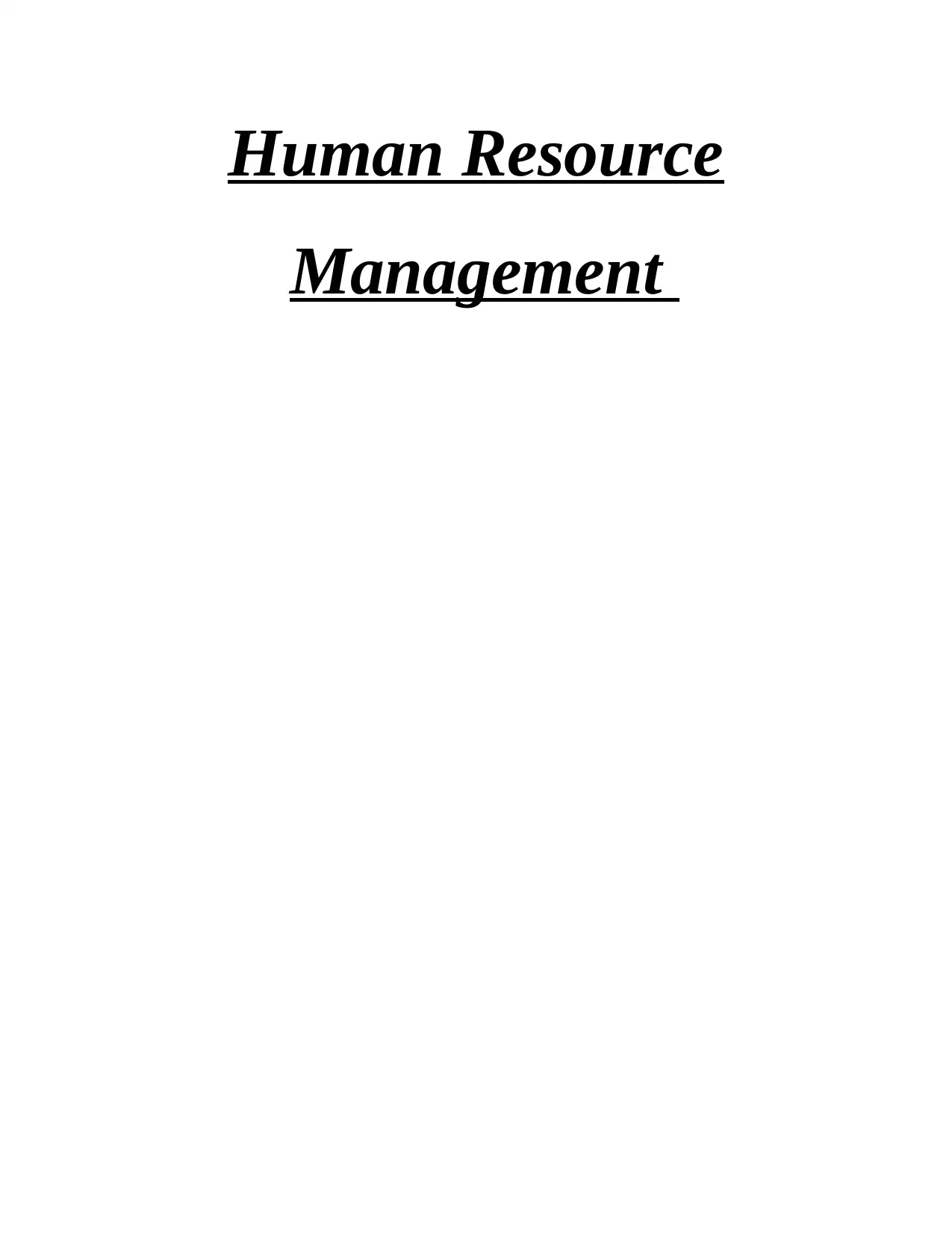
Human Resource
Management
Management
Paraphrase This Document
Need a fresh take? Get an instant paraphrase of this document with our AI Paraphraser
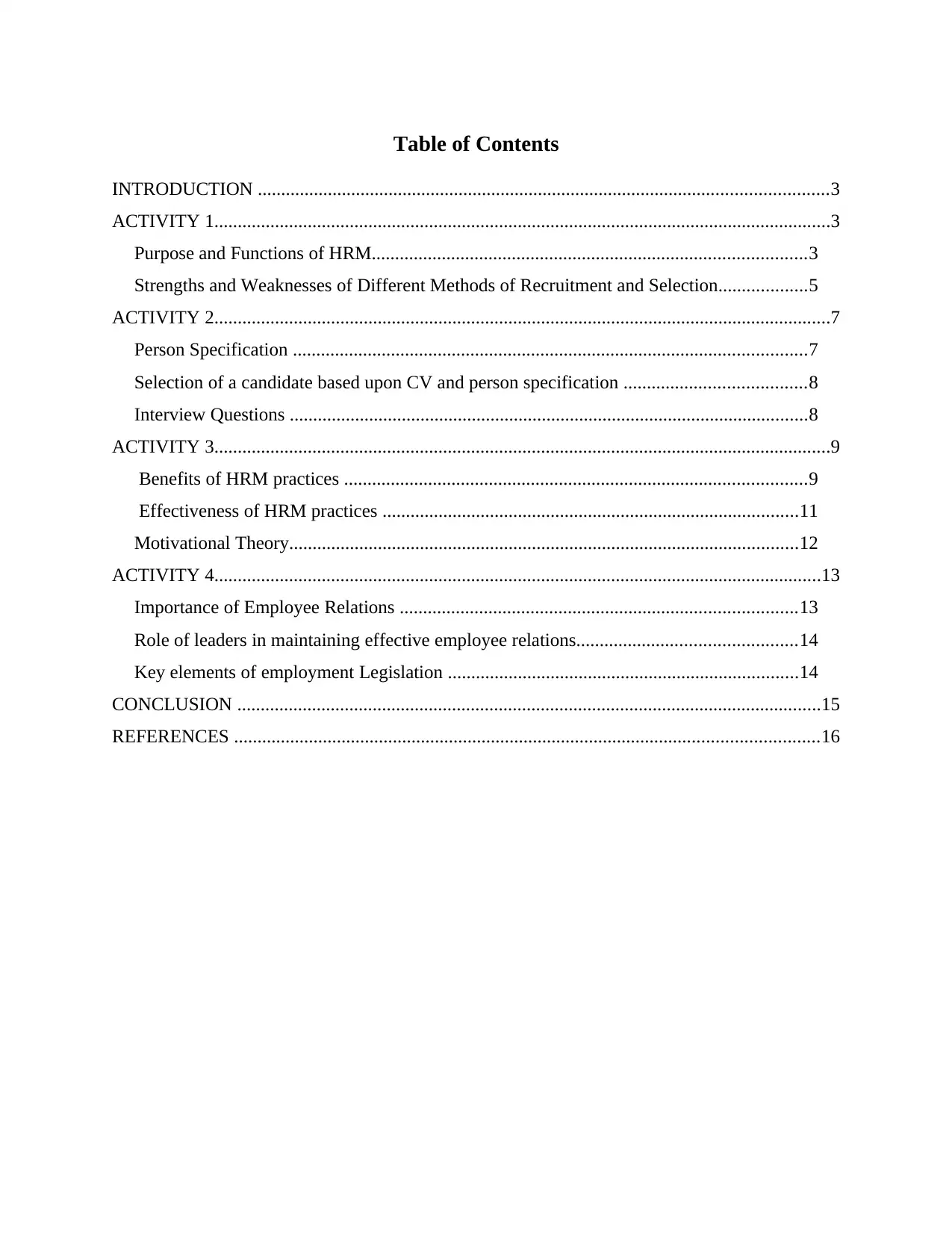
Table of Contents
INTRODUCTION ..........................................................................................................................3
ACTIVITY 1....................................................................................................................................3
Purpose and Functions of HRM.............................................................................................3
Strengths and Weaknesses of Different Methods of Recruitment and Selection...................5
ACTIVITY 2....................................................................................................................................7
Person Specification ..............................................................................................................7
Selection of a candidate based upon CV and person specification .......................................8
Interview Questions ...............................................................................................................8
ACTIVITY 3....................................................................................................................................9
Benefits of HRM practices ...................................................................................................9
Effectiveness of HRM practices .........................................................................................11
Motivational Theory.............................................................................................................12
ACTIVITY 4..................................................................................................................................13
Importance of Employee Relations .....................................................................................13
Role of leaders in maintaining effective employee relations...............................................14
Key elements of employment Legislation ...........................................................................14
CONCLUSION .............................................................................................................................15
REFERENCES .............................................................................................................................16
INTRODUCTION ..........................................................................................................................3
ACTIVITY 1....................................................................................................................................3
Purpose and Functions of HRM.............................................................................................3
Strengths and Weaknesses of Different Methods of Recruitment and Selection...................5
ACTIVITY 2....................................................................................................................................7
Person Specification ..............................................................................................................7
Selection of a candidate based upon CV and person specification .......................................8
Interview Questions ...............................................................................................................8
ACTIVITY 3....................................................................................................................................9
Benefits of HRM practices ...................................................................................................9
Effectiveness of HRM practices .........................................................................................11
Motivational Theory.............................................................................................................12
ACTIVITY 4..................................................................................................................................13
Importance of Employee Relations .....................................................................................13
Role of leaders in maintaining effective employee relations...............................................14
Key elements of employment Legislation ...........................................................................14
CONCLUSION .............................................................................................................................15
REFERENCES .............................................................................................................................16
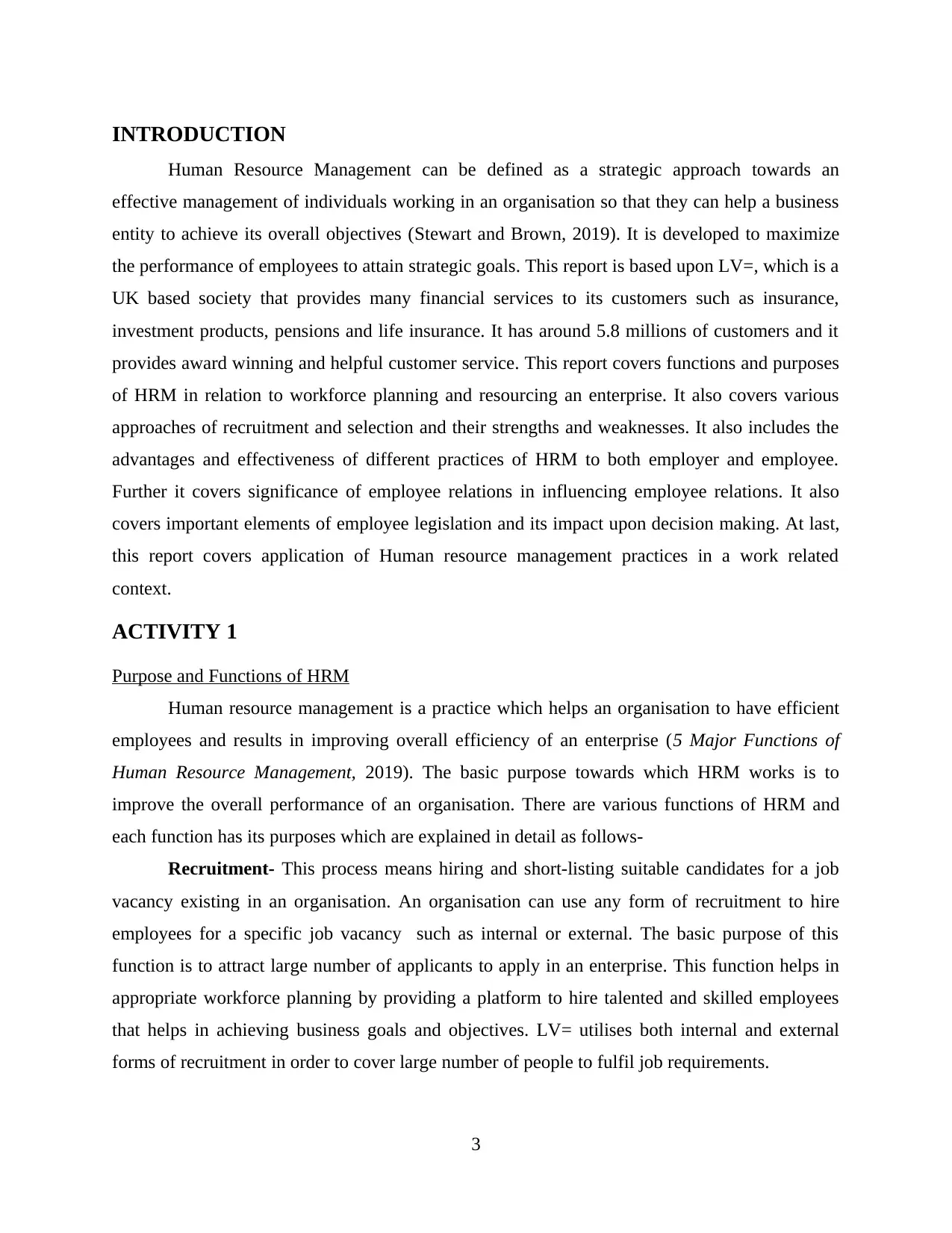
INTRODUCTION
Human Resource Management can be defined as a strategic approach towards an
effective management of individuals working in an organisation so that they can help a business
entity to achieve its overall objectives (Stewart and Brown, 2019). It is developed to maximize
the performance of employees to attain strategic goals. This report is based upon LV=, which is a
UK based society that provides many financial services to its customers such as insurance,
investment products, pensions and life insurance. It has around 5.8 millions of customers and it
provides award winning and helpful customer service. This report covers functions and purposes
of HRM in relation to workforce planning and resourcing an enterprise. It also covers various
approaches of recruitment and selection and their strengths and weaknesses. It also includes the
advantages and effectiveness of different practices of HRM to both employer and employee.
Further it covers significance of employee relations in influencing employee relations. It also
covers important elements of employee legislation and its impact upon decision making. At last,
this report covers application of Human resource management practices in a work related
context.
ACTIVITY 1
Purpose and Functions of HRM
Human resource management is a practice which helps an organisation to have efficient
employees and results in improving overall efficiency of an enterprise (5 Major Functions of
Human Resource Management, 2019). The basic purpose towards which HRM works is to
improve the overall performance of an organisation. There are various functions of HRM and
each function has its purposes which are explained in detail as follows-
Recruitment- This process means hiring and short-listing suitable candidates for a job
vacancy existing in an organisation. An organisation can use any form of recruitment to hire
employees for a specific job vacancy such as internal or external. The basic purpose of this
function is to attract large number of applicants to apply in an enterprise. This function helps in
appropriate workforce planning by providing a platform to hire talented and skilled employees
that helps in achieving business goals and objectives. LV= utilises both internal and external
forms of recruitment in order to cover large number of people to fulfil job requirements.
3
Human Resource Management can be defined as a strategic approach towards an
effective management of individuals working in an organisation so that they can help a business
entity to achieve its overall objectives (Stewart and Brown, 2019). It is developed to maximize
the performance of employees to attain strategic goals. This report is based upon LV=, which is a
UK based society that provides many financial services to its customers such as insurance,
investment products, pensions and life insurance. It has around 5.8 millions of customers and it
provides award winning and helpful customer service. This report covers functions and purposes
of HRM in relation to workforce planning and resourcing an enterprise. It also covers various
approaches of recruitment and selection and their strengths and weaknesses. It also includes the
advantages and effectiveness of different practices of HRM to both employer and employee.
Further it covers significance of employee relations in influencing employee relations. It also
covers important elements of employee legislation and its impact upon decision making. At last,
this report covers application of Human resource management practices in a work related
context.
ACTIVITY 1
Purpose and Functions of HRM
Human resource management is a practice which helps an organisation to have efficient
employees and results in improving overall efficiency of an enterprise (5 Major Functions of
Human Resource Management, 2019). The basic purpose towards which HRM works is to
improve the overall performance of an organisation. There are various functions of HRM and
each function has its purposes which are explained in detail as follows-
Recruitment- This process means hiring and short-listing suitable candidates for a job
vacancy existing in an organisation. An organisation can use any form of recruitment to hire
employees for a specific job vacancy such as internal or external. The basic purpose of this
function is to attract large number of applicants to apply in an enterprise. This function helps in
appropriate workforce planning by providing a platform to hire talented and skilled employees
that helps in achieving business goals and objectives. LV= utilises both internal and external
forms of recruitment in order to cover large number of people to fulfil job requirements.
3
⊘ This is a preview!⊘
Do you want full access?
Subscribe today to unlock all pages.

Trusted by 1+ million students worldwide
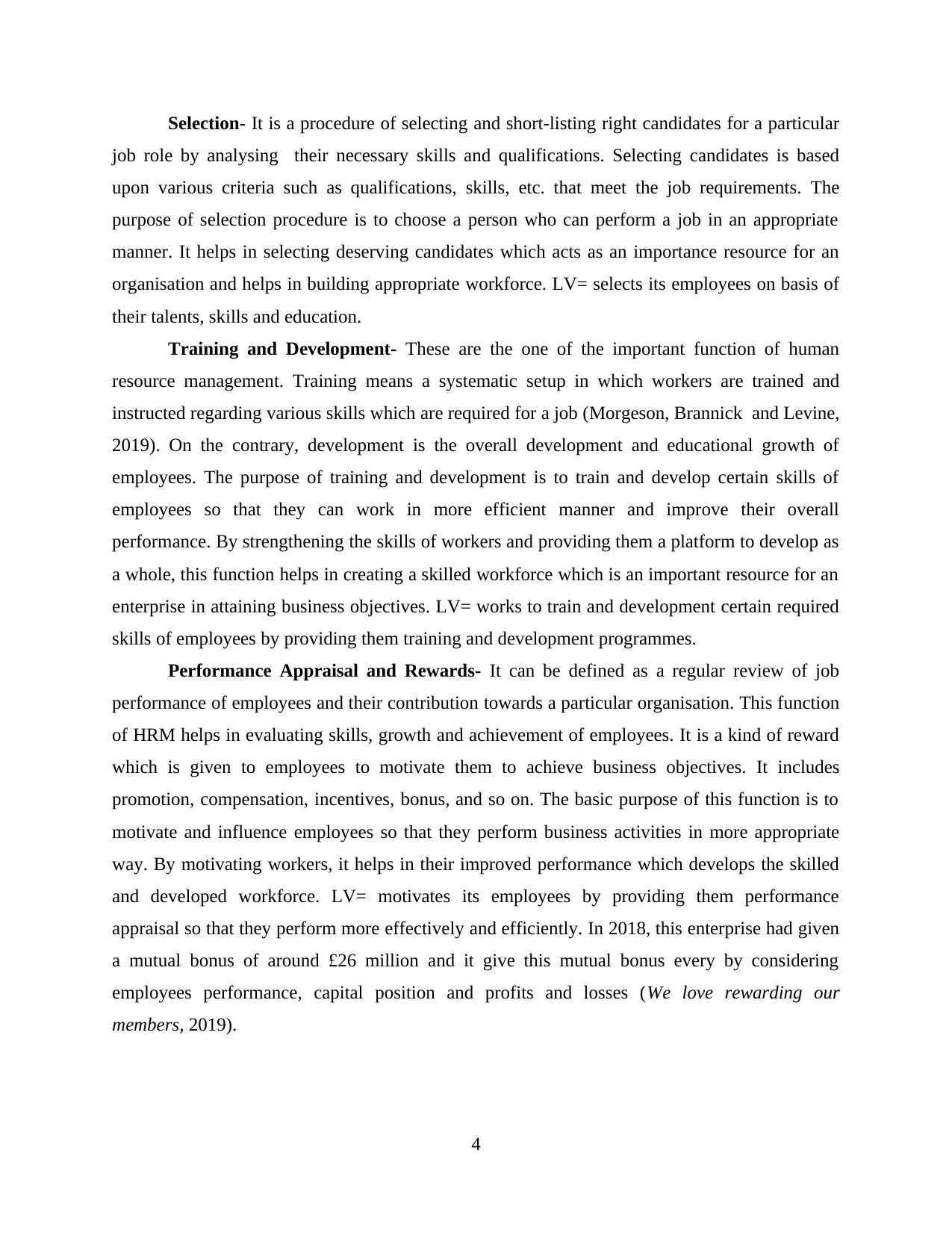
Selection- It is a procedure of selecting and short-listing right candidates for a particular
job role by analysing their necessary skills and qualifications. Selecting candidates is based
upon various criteria such as qualifications, skills, etc. that meet the job requirements. The
purpose of selection procedure is to choose a person who can perform a job in an appropriate
manner. It helps in selecting deserving candidates which acts as an importance resource for an
organisation and helps in building appropriate workforce. LV= selects its employees on basis of
their talents, skills and education.
Training and Development- These are the one of the important function of human
resource management. Training means a systematic setup in which workers are trained and
instructed regarding various skills which are required for a job (Morgeson, Brannick and Levine,
2019). On the contrary, development is the overall development and educational growth of
employees. The purpose of training and development is to train and develop certain skills of
employees so that they can work in more efficient manner and improve their overall
performance. By strengthening the skills of workers and providing them a platform to develop as
a whole, this function helps in creating a skilled workforce which is an important resource for an
enterprise in attaining business objectives. LV= works to train and development certain required
skills of employees by providing them training and development programmes.
Performance Appraisal and Rewards- It can be defined as a regular review of job
performance of employees and their contribution towards a particular organisation. This function
of HRM helps in evaluating skills, growth and achievement of employees. It is a kind of reward
which is given to employees to motivate them to achieve business objectives. It includes
promotion, compensation, incentives, bonus, and so on. The basic purpose of this function is to
motivate and influence employees so that they perform business activities in more appropriate
way. By motivating workers, it helps in their improved performance which develops the skilled
and developed workforce. LV= motivates its employees by providing them performance
appraisal so that they perform more effectively and efficiently. In 2018, this enterprise had given
a mutual bonus of around £26 million and it give this mutual bonus every by considering
employees performance, capital position and profits and losses (We love rewarding our
members, 2019).
4
job role by analysing their necessary skills and qualifications. Selecting candidates is based
upon various criteria such as qualifications, skills, etc. that meet the job requirements. The
purpose of selection procedure is to choose a person who can perform a job in an appropriate
manner. It helps in selecting deserving candidates which acts as an importance resource for an
organisation and helps in building appropriate workforce. LV= selects its employees on basis of
their talents, skills and education.
Training and Development- These are the one of the important function of human
resource management. Training means a systematic setup in which workers are trained and
instructed regarding various skills which are required for a job (Morgeson, Brannick and Levine,
2019). On the contrary, development is the overall development and educational growth of
employees. The purpose of training and development is to train and develop certain skills of
employees so that they can work in more efficient manner and improve their overall
performance. By strengthening the skills of workers and providing them a platform to develop as
a whole, this function helps in creating a skilled workforce which is an important resource for an
enterprise in attaining business objectives. LV= works to train and development certain required
skills of employees by providing them training and development programmes.
Performance Appraisal and Rewards- It can be defined as a regular review of job
performance of employees and their contribution towards a particular organisation. This function
of HRM helps in evaluating skills, growth and achievement of employees. It is a kind of reward
which is given to employees to motivate them to achieve business objectives. It includes
promotion, compensation, incentives, bonus, and so on. The basic purpose of this function is to
motivate and influence employees so that they perform business activities in more appropriate
way. By motivating workers, it helps in their improved performance which develops the skilled
and developed workforce. LV= motivates its employees by providing them performance
appraisal so that they perform more effectively and efficiently. In 2018, this enterprise had given
a mutual bonus of around £26 million and it give this mutual bonus every by considering
employees performance, capital position and profits and losses (We love rewarding our
members, 2019).
4
Paraphrase This Document
Need a fresh take? Get an instant paraphrase of this document with our AI Paraphraser
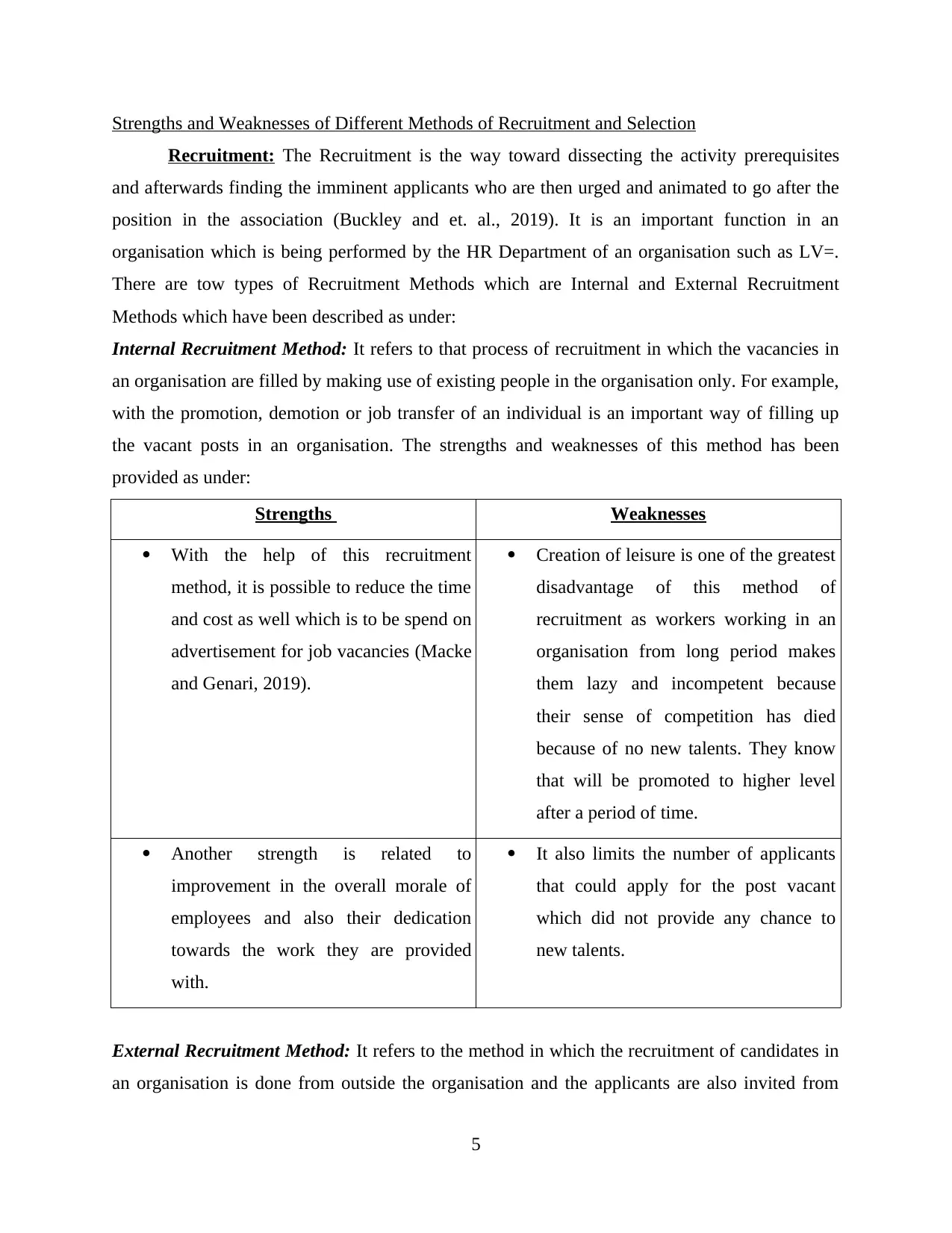
Strengths and Weaknesses of Different Methods of Recruitment and Selection
Recruitment: The Recruitment is the way toward dissecting the activity prerequisites
and afterwards finding the imminent applicants who are then urged and animated to go after the
position in the association (Buckley and et. al., 2019). It is an important function in an
organisation which is being performed by the HR Department of an organisation such as LV=.
There are tow types of Recruitment Methods which are Internal and External Recruitment
Methods which have been described as under:
Internal Recruitment Method: It refers to that process of recruitment in which the vacancies in
an organisation are filled by making use of existing people in the organisation only. For example,
with the promotion, demotion or job transfer of an individual is an important way of filling up
the vacant posts in an organisation. The strengths and weaknesses of this method has been
provided as under:
Strengths Weaknesses
With the help of this recruitment
method, it is possible to reduce the time
and cost as well which is to be spend on
advertisement for job vacancies (Macke
and Genari, 2019).
Creation of leisure is one of the greatest
disadvantage of this method of
recruitment as workers working in an
organisation from long period makes
them lazy and incompetent because
their sense of competition has died
because of no new talents. They know
that will be promoted to higher level
after a period of time.
Another strength is related to
improvement in the overall morale of
employees and also their dedication
towards the work they are provided
with.
It also limits the number of applicants
that could apply for the post vacant
which did not provide any chance to
new talents.
External Recruitment Method: It refers to the method in which the recruitment of candidates in
an organisation is done from outside the organisation and the applicants are also invited from
5
Recruitment: The Recruitment is the way toward dissecting the activity prerequisites
and afterwards finding the imminent applicants who are then urged and animated to go after the
position in the association (Buckley and et. al., 2019). It is an important function in an
organisation which is being performed by the HR Department of an organisation such as LV=.
There are tow types of Recruitment Methods which are Internal and External Recruitment
Methods which have been described as under:
Internal Recruitment Method: It refers to that process of recruitment in which the vacancies in
an organisation are filled by making use of existing people in the organisation only. For example,
with the promotion, demotion or job transfer of an individual is an important way of filling up
the vacant posts in an organisation. The strengths and weaknesses of this method has been
provided as under:
Strengths Weaknesses
With the help of this recruitment
method, it is possible to reduce the time
and cost as well which is to be spend on
advertisement for job vacancies (Macke
and Genari, 2019).
Creation of leisure is one of the greatest
disadvantage of this method of
recruitment as workers working in an
organisation from long period makes
them lazy and incompetent because
their sense of competition has died
because of no new talents. They know
that will be promoted to higher level
after a period of time.
Another strength is related to
improvement in the overall morale of
employees and also their dedication
towards the work they are provided
with.
It also limits the number of applicants
that could apply for the post vacant
which did not provide any chance to
new talents.
External Recruitment Method: It refers to the method in which the recruitment of candidates in
an organisation is done from outside the organisation and the applicants are also invited from
5
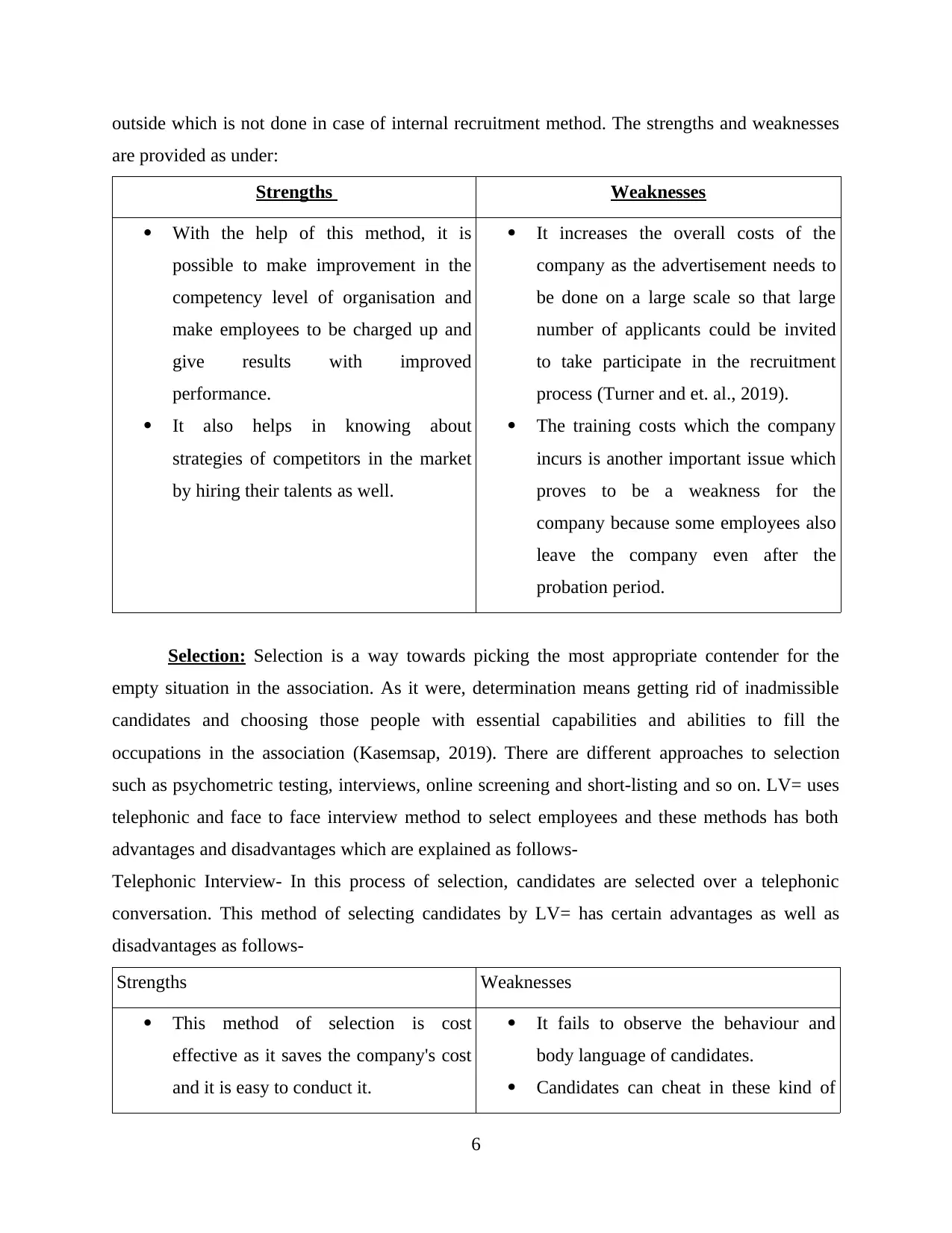
outside which is not done in case of internal recruitment method. The strengths and weaknesses
are provided as under:
Strengths Weaknesses
With the help of this method, it is
possible to make improvement in the
competency level of organisation and
make employees to be charged up and
give results with improved
performance.
It also helps in knowing about
strategies of competitors in the market
by hiring their talents as well.
It increases the overall costs of the
company as the advertisement needs to
be done on a large scale so that large
number of applicants could be invited
to take participate in the recruitment
process (Turner and et. al., 2019).
The training costs which the company
incurs is another important issue which
proves to be a weakness for the
company because some employees also
leave the company even after the
probation period.
Selection: Selection is a way towards picking the most appropriate contender for the
empty situation in the association. As it were, determination means getting rid of inadmissible
candidates and choosing those people with essential capabilities and abilities to fill the
occupations in the association (Kasemsap, 2019). There are different approaches to selection
such as psychometric testing, interviews, online screening and short-listing and so on. LV= uses
telephonic and face to face interview method to select employees and these methods has both
advantages and disadvantages which are explained as follows-
Telephonic Interview- In this process of selection, candidates are selected over a telephonic
conversation. This method of selecting candidates by LV= has certain advantages as well as
disadvantages as follows-
Strengths Weaknesses
This method of selection is cost
effective as it saves the company's cost
and it is easy to conduct it.
It fails to observe the behaviour and
body language of candidates.
Candidates can cheat in these kind of
6
are provided as under:
Strengths Weaknesses
With the help of this method, it is
possible to make improvement in the
competency level of organisation and
make employees to be charged up and
give results with improved
performance.
It also helps in knowing about
strategies of competitors in the market
by hiring their talents as well.
It increases the overall costs of the
company as the advertisement needs to
be done on a large scale so that large
number of applicants could be invited
to take participate in the recruitment
process (Turner and et. al., 2019).
The training costs which the company
incurs is another important issue which
proves to be a weakness for the
company because some employees also
leave the company even after the
probation period.
Selection: Selection is a way towards picking the most appropriate contender for the
empty situation in the association. As it were, determination means getting rid of inadmissible
candidates and choosing those people with essential capabilities and abilities to fill the
occupations in the association (Kasemsap, 2019). There are different approaches to selection
such as psychometric testing, interviews, online screening and short-listing and so on. LV= uses
telephonic and face to face interview method to select employees and these methods has both
advantages and disadvantages which are explained as follows-
Telephonic Interview- In this process of selection, candidates are selected over a telephonic
conversation. This method of selecting candidates by LV= has certain advantages as well as
disadvantages as follows-
Strengths Weaknesses
This method of selection is cost
effective as it saves the company's cost
and it is easy to conduct it.
It fails to observe the behaviour and
body language of candidates.
Candidates can cheat in these kind of
6
⊘ This is a preview!⊘
Do you want full access?
Subscribe today to unlock all pages.

Trusted by 1+ million students worldwide
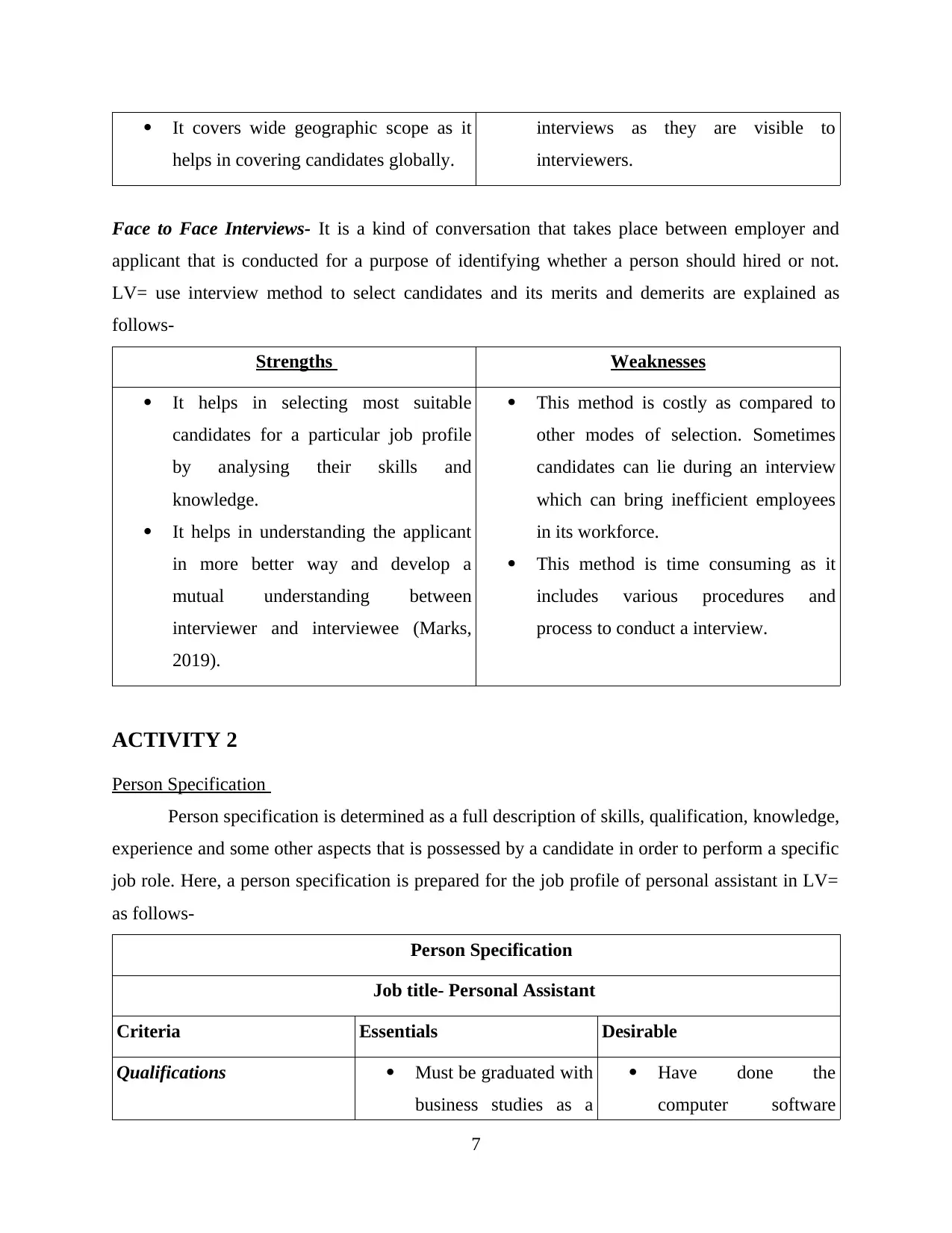
It covers wide geographic scope as it
helps in covering candidates globally.
interviews as they are visible to
interviewers.
Face to Face Interviews- It is a kind of conversation that takes place between employer and
applicant that is conducted for a purpose of identifying whether a person should hired or not.
LV= use interview method to select candidates and its merits and demerits are explained as
follows-
Strengths Weaknesses
It helps in selecting most suitable
candidates for a particular job profile
by analysing their skills and
knowledge.
It helps in understanding the applicant
in more better way and develop a
mutual understanding between
interviewer and interviewee (Marks,
2019).
This method is costly as compared to
other modes of selection. Sometimes
candidates can lie during an interview
which can bring inefficient employees
in its workforce.
This method is time consuming as it
includes various procedures and
process to conduct a interview.
ACTIVITY 2
Person Specification
Person specification is determined as a full description of skills, qualification, knowledge,
experience and some other aspects that is possessed by a candidate in order to perform a specific
job role. Here, a person specification is prepared for the job profile of personal assistant in LV=
as follows-
Person Specification
Job title- Personal Assistant
Criteria Essentials Desirable
Qualifications Must be graduated with
business studies as a
Have done the
computer software
7
helps in covering candidates globally.
interviews as they are visible to
interviewers.
Face to Face Interviews- It is a kind of conversation that takes place between employer and
applicant that is conducted for a purpose of identifying whether a person should hired or not.
LV= use interview method to select candidates and its merits and demerits are explained as
follows-
Strengths Weaknesses
It helps in selecting most suitable
candidates for a particular job profile
by analysing their skills and
knowledge.
It helps in understanding the applicant
in more better way and develop a
mutual understanding between
interviewer and interviewee (Marks,
2019).
This method is costly as compared to
other modes of selection. Sometimes
candidates can lie during an interview
which can bring inefficient employees
in its workforce.
This method is time consuming as it
includes various procedures and
process to conduct a interview.
ACTIVITY 2
Person Specification
Person specification is determined as a full description of skills, qualification, knowledge,
experience and some other aspects that is possessed by a candidate in order to perform a specific
job role. Here, a person specification is prepared for the job profile of personal assistant in LV=
as follows-
Person Specification
Job title- Personal Assistant
Criteria Essentials Desirable
Qualifications Must be graduated with
business studies as a
Have done the
computer software
7
Paraphrase This Document
Need a fresh take? Get an instant paraphrase of this document with our AI Paraphraser
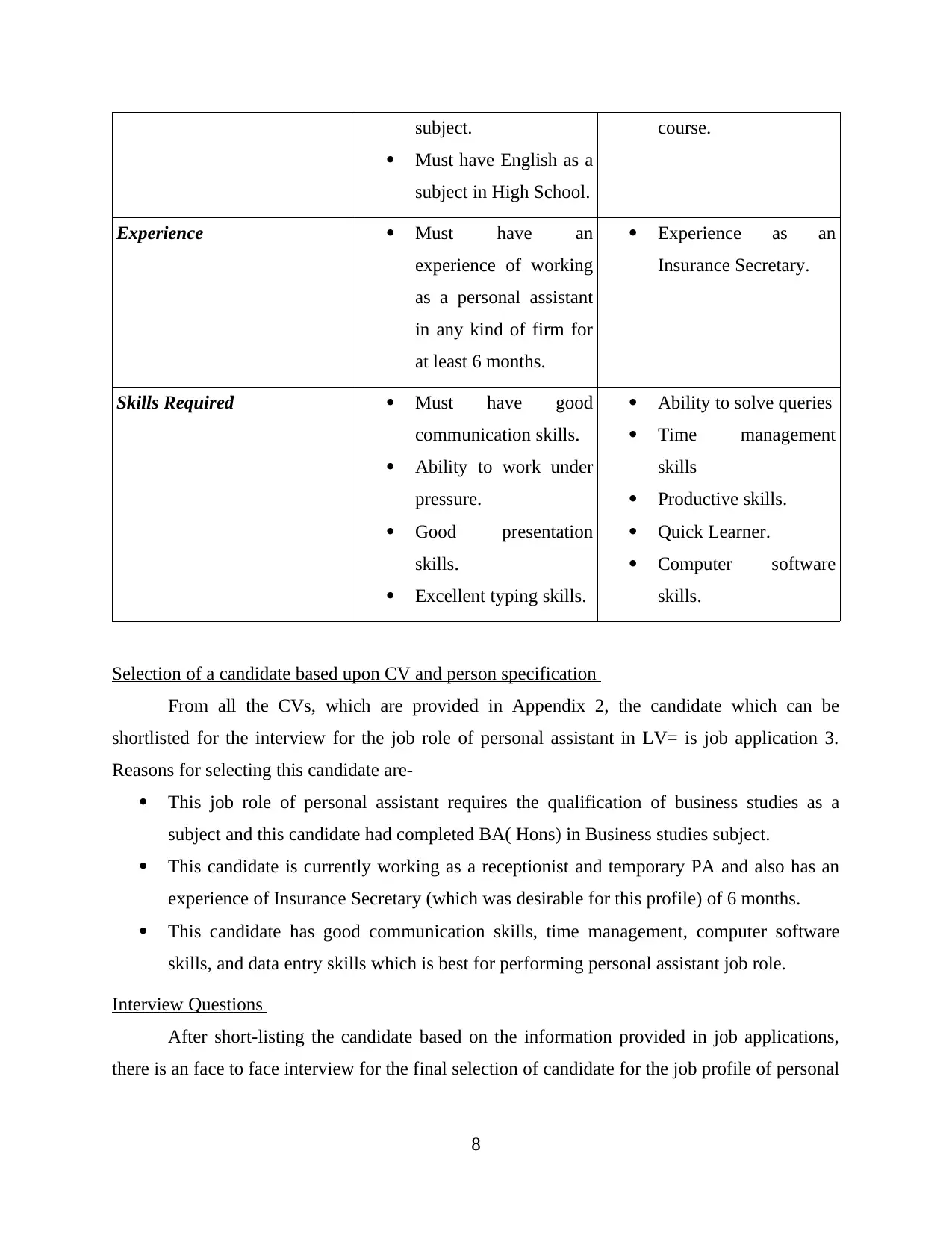
subject.
Must have English as a
subject in High School.
course.
Experience Must have an
experience of working
as a personal assistant
in any kind of firm for
at least 6 months.
Experience as an
Insurance Secretary.
Skills Required Must have good
communication skills.
Ability to work under
pressure.
Good presentation
skills.
Excellent typing skills.
Ability to solve queries
Time management
skills
Productive skills.
Quick Learner.
Computer software
skills.
Selection of a candidate based upon CV and person specification
From all the CVs, which are provided in Appendix 2, the candidate which can be
shortlisted for the interview for the job role of personal assistant in LV= is job application 3.
Reasons for selecting this candidate are-
This job role of personal assistant requires the qualification of business studies as a
subject and this candidate had completed BA( Hons) in Business studies subject.
This candidate is currently working as a receptionist and temporary PA and also has an
experience of Insurance Secretary (which was desirable for this profile) of 6 months.
This candidate has good communication skills, time management, computer software
skills, and data entry skills which is best for performing personal assistant job role.
Interview Questions
After short-listing the candidate based on the information provided in job applications,
there is an face to face interview for the final selection of candidate for the job profile of personal
8
Must have English as a
subject in High School.
course.
Experience Must have an
experience of working
as a personal assistant
in any kind of firm for
at least 6 months.
Experience as an
Insurance Secretary.
Skills Required Must have good
communication skills.
Ability to work under
pressure.
Good presentation
skills.
Excellent typing skills.
Ability to solve queries
Time management
skills
Productive skills.
Quick Learner.
Computer software
skills.
Selection of a candidate based upon CV and person specification
From all the CVs, which are provided in Appendix 2, the candidate which can be
shortlisted for the interview for the job role of personal assistant in LV= is job application 3.
Reasons for selecting this candidate are-
This job role of personal assistant requires the qualification of business studies as a
subject and this candidate had completed BA( Hons) in Business studies subject.
This candidate is currently working as a receptionist and temporary PA and also has an
experience of Insurance Secretary (which was desirable for this profile) of 6 months.
This candidate has good communication skills, time management, computer software
skills, and data entry skills which is best for performing personal assistant job role.
Interview Questions
After short-listing the candidate based on the information provided in job applications,
there is an face to face interview for the final selection of candidate for the job profile of personal
8
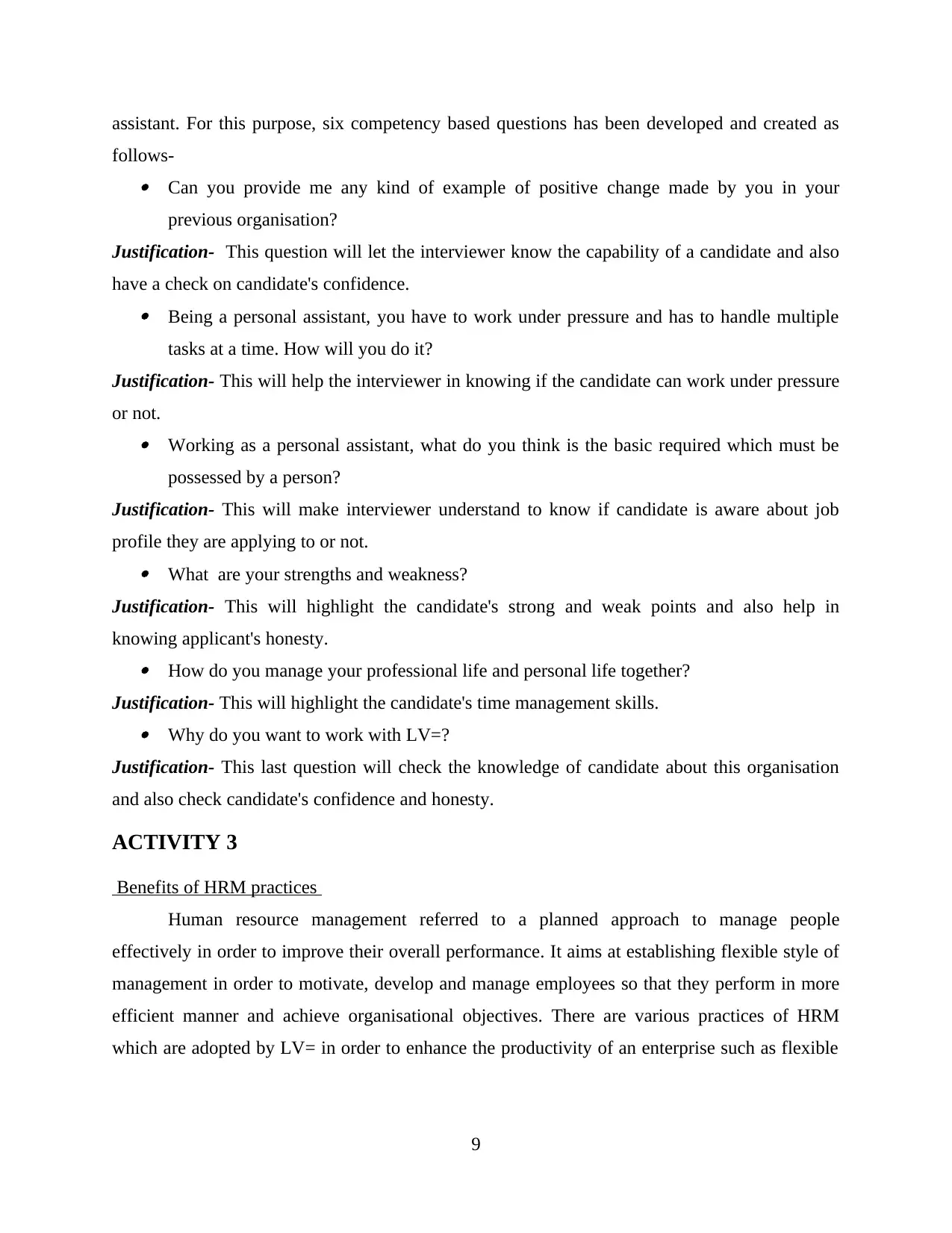
assistant. For this purpose, six competency based questions has been developed and created as
follows- Can you provide me any kind of example of positive change made by you in your
previous organisation?
Justification- This question will let the interviewer know the capability of a candidate and also
have a check on candidate's confidence. Being a personal assistant, you have to work under pressure and has to handle multiple
tasks at a time. How will you do it?
Justification- This will help the interviewer in knowing if the candidate can work under pressure
or not. Working as a personal assistant, what do you think is the basic required which must be
possessed by a person?
Justification- This will make interviewer understand to know if candidate is aware about job
profile they are applying to or not. What are your strengths and weakness?
Justification- This will highlight the candidate's strong and weak points and also help in
knowing applicant's honesty. How do you manage your professional life and personal life together?
Justification- This will highlight the candidate's time management skills. Why do you want to work with LV=?
Justification- This last question will check the knowledge of candidate about this organisation
and also check candidate's confidence and honesty.
ACTIVITY 3
Benefits of HRM practices
Human resource management referred to a planned approach to manage people
effectively in order to improve their overall performance. It aims at establishing flexible style of
management in order to motivate, develop and manage employees so that they perform in more
efficient manner and achieve organisational objectives. There are various practices of HRM
which are adopted by LV= in order to enhance the productivity of an enterprise such as flexible
9
follows- Can you provide me any kind of example of positive change made by you in your
previous organisation?
Justification- This question will let the interviewer know the capability of a candidate and also
have a check on candidate's confidence. Being a personal assistant, you have to work under pressure and has to handle multiple
tasks at a time. How will you do it?
Justification- This will help the interviewer in knowing if the candidate can work under pressure
or not. Working as a personal assistant, what do you think is the basic required which must be
possessed by a person?
Justification- This will make interviewer understand to know if candidate is aware about job
profile they are applying to or not. What are your strengths and weakness?
Justification- This will highlight the candidate's strong and weak points and also help in
knowing applicant's honesty. How do you manage your professional life and personal life together?
Justification- This will highlight the candidate's time management skills. Why do you want to work with LV=?
Justification- This last question will check the knowledge of candidate about this organisation
and also check candidate's confidence and honesty.
ACTIVITY 3
Benefits of HRM practices
Human resource management referred to a planned approach to manage people
effectively in order to improve their overall performance. It aims at establishing flexible style of
management in order to motivate, develop and manage employees so that they perform in more
efficient manner and achieve organisational objectives. There are various practices of HRM
which are adopted by LV= in order to enhance the productivity of an enterprise such as flexible
9
⊘ This is a preview!⊘
Do you want full access?
Subscribe today to unlock all pages.

Trusted by 1+ million students worldwide
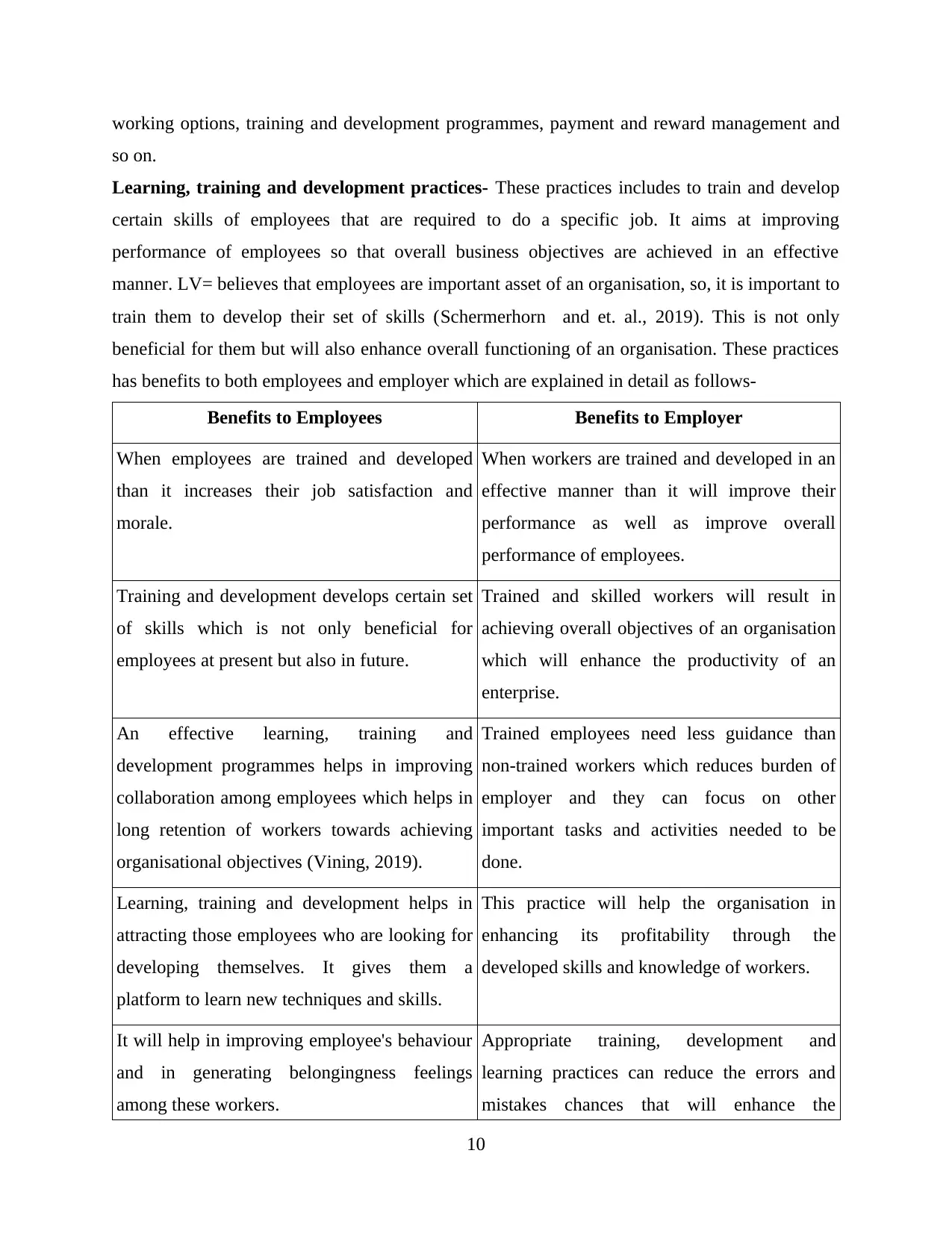
working options, training and development programmes, payment and reward management and
so on.
Learning, training and development practices- These practices includes to train and develop
certain skills of employees that are required to do a specific job. It aims at improving
performance of employees so that overall business objectives are achieved in an effective
manner. LV= believes that employees are important asset of an organisation, so, it is important to
train them to develop their set of skills (Schermerhorn and et. al., 2019). This is not only
beneficial for them but will also enhance overall functioning of an organisation. These practices
has benefits to both employees and employer which are explained in detail as follows-
Benefits to Employees Benefits to Employer
When employees are trained and developed
than it increases their job satisfaction and
morale.
When workers are trained and developed in an
effective manner than it will improve their
performance as well as improve overall
performance of employees.
Training and development develops certain set
of skills which is not only beneficial for
employees at present but also in future.
Trained and skilled workers will result in
achieving overall objectives of an organisation
which will enhance the productivity of an
enterprise.
An effective learning, training and
development programmes helps in improving
collaboration among employees which helps in
long retention of workers towards achieving
organisational objectives (Vining, 2019).
Trained employees need less guidance than
non-trained workers which reduces burden of
employer and they can focus on other
important tasks and activities needed to be
done.
Learning, training and development helps in
attracting those employees who are looking for
developing themselves. It gives them a
platform to learn new techniques and skills.
This practice will help the organisation in
enhancing its profitability through the
developed skills and knowledge of workers.
It will help in improving employee's behaviour
and in generating belongingness feelings
among these workers.
Appropriate training, development and
learning practices can reduce the errors and
mistakes chances that will enhance the
10
so on.
Learning, training and development practices- These practices includes to train and develop
certain skills of employees that are required to do a specific job. It aims at improving
performance of employees so that overall business objectives are achieved in an effective
manner. LV= believes that employees are important asset of an organisation, so, it is important to
train them to develop their set of skills (Schermerhorn and et. al., 2019). This is not only
beneficial for them but will also enhance overall functioning of an organisation. These practices
has benefits to both employees and employer which are explained in detail as follows-
Benefits to Employees Benefits to Employer
When employees are trained and developed
than it increases their job satisfaction and
morale.
When workers are trained and developed in an
effective manner than it will improve their
performance as well as improve overall
performance of employees.
Training and development develops certain set
of skills which is not only beneficial for
employees at present but also in future.
Trained and skilled workers will result in
achieving overall objectives of an organisation
which will enhance the productivity of an
enterprise.
An effective learning, training and
development programmes helps in improving
collaboration among employees which helps in
long retention of workers towards achieving
organisational objectives (Vining, 2019).
Trained employees need less guidance than
non-trained workers which reduces burden of
employer and they can focus on other
important tasks and activities needed to be
done.
Learning, training and development helps in
attracting those employees who are looking for
developing themselves. It gives them a
platform to learn new techniques and skills.
This practice will help the organisation in
enhancing its profitability through the
developed skills and knowledge of workers.
It will help in improving employee's behaviour
and in generating belongingness feelings
among these workers.
Appropriate training, development and
learning practices can reduce the errors and
mistakes chances that will enhance the
10
Paraphrase This Document
Need a fresh take? Get an instant paraphrase of this document with our AI Paraphraser
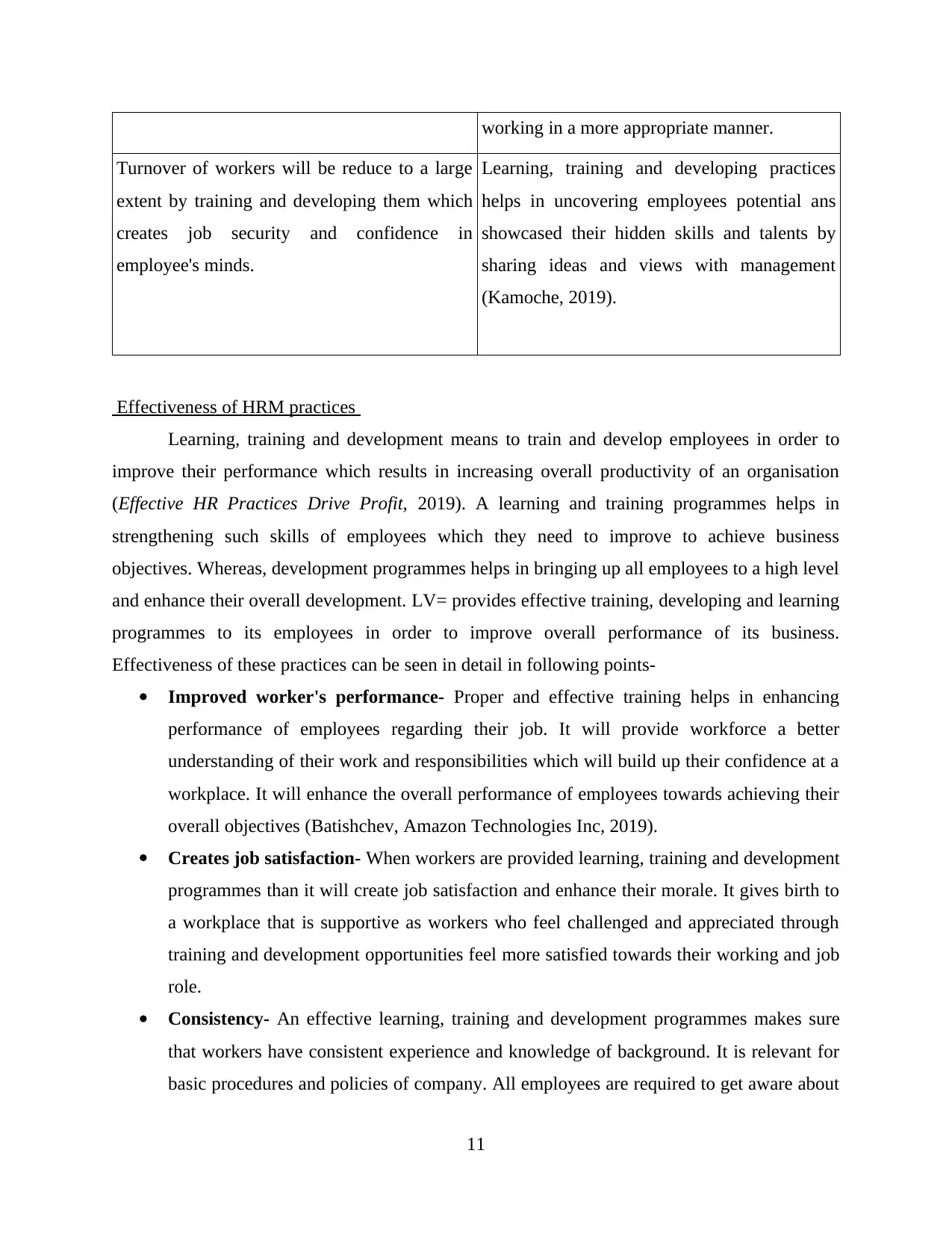
working in a more appropriate manner.
Turnover of workers will be reduce to a large
extent by training and developing them which
creates job security and confidence in
employee's minds.
Learning, training and developing practices
helps in uncovering employees potential ans
showcased their hidden skills and talents by
sharing ideas and views with management
(Kamoche, 2019).
Effectiveness of HRM practices
Learning, training and development means to train and develop employees in order to
improve their performance which results in increasing overall productivity of an organisation
(Effective HR Practices Drive Profit, 2019). A learning and training programmes helps in
strengthening such skills of employees which they need to improve to achieve business
objectives. Whereas, development programmes helps in bringing up all employees to a high level
and enhance their overall development. LV= provides effective training, developing and learning
programmes to its employees in order to improve overall performance of its business.
Effectiveness of these practices can be seen in detail in following points-
Improved worker's performance- Proper and effective training helps in enhancing
performance of employees regarding their job. It will provide workforce a better
understanding of their work and responsibilities which will build up their confidence at a
workplace. It will enhance the overall performance of employees towards achieving their
overall objectives (Batishchev, Amazon Technologies Inc, 2019).
Creates job satisfaction- When workers are provided learning, training and development
programmes than it will create job satisfaction and enhance their morale. It gives birth to
a workplace that is supportive as workers who feel challenged and appreciated through
training and development opportunities feel more satisfied towards their working and job
role.
Consistency- An effective learning, training and development programmes makes sure
that workers have consistent experience and knowledge of background. It is relevant for
basic procedures and policies of company. All employees are required to get aware about
11
Turnover of workers will be reduce to a large
extent by training and developing them which
creates job security and confidence in
employee's minds.
Learning, training and developing practices
helps in uncovering employees potential ans
showcased their hidden skills and talents by
sharing ideas and views with management
(Kamoche, 2019).
Effectiveness of HRM practices
Learning, training and development means to train and develop employees in order to
improve their performance which results in increasing overall productivity of an organisation
(Effective HR Practices Drive Profit, 2019). A learning and training programmes helps in
strengthening such skills of employees which they need to improve to achieve business
objectives. Whereas, development programmes helps in bringing up all employees to a high level
and enhance their overall development. LV= provides effective training, developing and learning
programmes to its employees in order to improve overall performance of its business.
Effectiveness of these practices can be seen in detail in following points-
Improved worker's performance- Proper and effective training helps in enhancing
performance of employees regarding their job. It will provide workforce a better
understanding of their work and responsibilities which will build up their confidence at a
workplace. It will enhance the overall performance of employees towards achieving their
overall objectives (Batishchev, Amazon Technologies Inc, 2019).
Creates job satisfaction- When workers are provided learning, training and development
programmes than it will create job satisfaction and enhance their morale. It gives birth to
a workplace that is supportive as workers who feel challenged and appreciated through
training and development opportunities feel more satisfied towards their working and job
role.
Consistency- An effective learning, training and development programmes makes sure
that workers have consistent experience and knowledge of background. It is relevant for
basic procedures and policies of company. All employees are required to get aware about
11
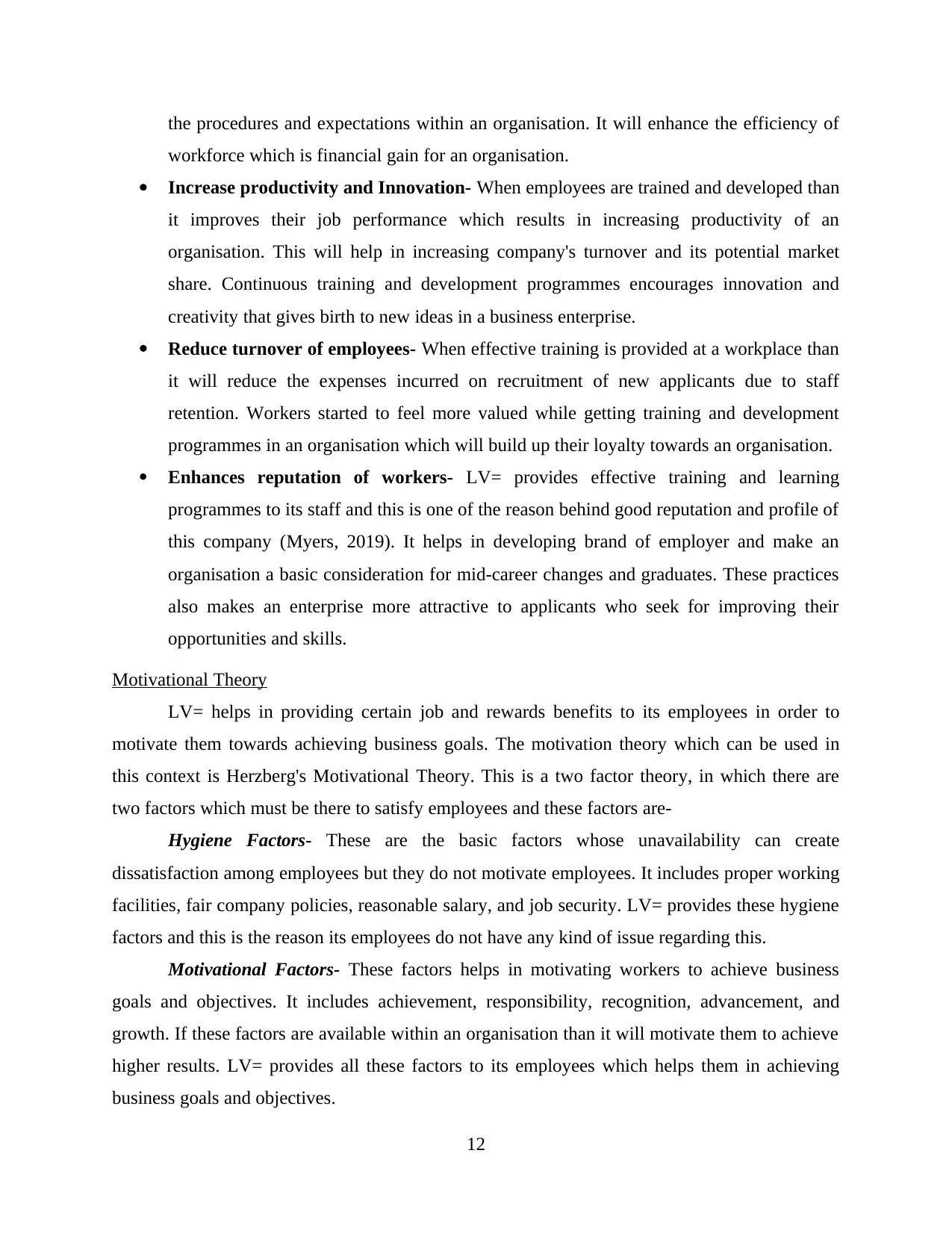
the procedures and expectations within an organisation. It will enhance the efficiency of
workforce which is financial gain for an organisation.
Increase productivity and Innovation- When employees are trained and developed than
it improves their job performance which results in increasing productivity of an
organisation. This will help in increasing company's turnover and its potential market
share. Continuous training and development programmes encourages innovation and
creativity that gives birth to new ideas in a business enterprise.
Reduce turnover of employees- When effective training is provided at a workplace than
it will reduce the expenses incurred on recruitment of new applicants due to staff
retention. Workers started to feel more valued while getting training and development
programmes in an organisation which will build up their loyalty towards an organisation.
Enhances reputation of workers- LV= provides effective training and learning
programmes to its staff and this is one of the reason behind good reputation and profile of
this company (Myers, 2019). It helps in developing brand of employer and make an
organisation a basic consideration for mid-career changes and graduates. These practices
also makes an enterprise more attractive to applicants who seek for improving their
opportunities and skills.
Motivational Theory
LV= helps in providing certain job and rewards benefits to its employees in order to
motivate them towards achieving business goals. The motivation theory which can be used in
this context is Herzberg's Motivational Theory. This is a two factor theory, in which there are
two factors which must be there to satisfy employees and these factors are-
Hygiene Factors- These are the basic factors whose unavailability can create
dissatisfaction among employees but they do not motivate employees. It includes proper working
facilities, fair company policies, reasonable salary, and job security. LV= provides these hygiene
factors and this is the reason its employees do not have any kind of issue regarding this.
Motivational Factors- These factors helps in motivating workers to achieve business
goals and objectives. It includes achievement, responsibility, recognition, advancement, and
growth. If these factors are available within an organisation than it will motivate them to achieve
higher results. LV= provides all these factors to its employees which helps them in achieving
business goals and objectives.
12
workforce which is financial gain for an organisation.
Increase productivity and Innovation- When employees are trained and developed than
it improves their job performance which results in increasing productivity of an
organisation. This will help in increasing company's turnover and its potential market
share. Continuous training and development programmes encourages innovation and
creativity that gives birth to new ideas in a business enterprise.
Reduce turnover of employees- When effective training is provided at a workplace than
it will reduce the expenses incurred on recruitment of new applicants due to staff
retention. Workers started to feel more valued while getting training and development
programmes in an organisation which will build up their loyalty towards an organisation.
Enhances reputation of workers- LV= provides effective training and learning
programmes to its staff and this is one of the reason behind good reputation and profile of
this company (Myers, 2019). It helps in developing brand of employer and make an
organisation a basic consideration for mid-career changes and graduates. These practices
also makes an enterprise more attractive to applicants who seek for improving their
opportunities and skills.
Motivational Theory
LV= helps in providing certain job and rewards benefits to its employees in order to
motivate them towards achieving business goals. The motivation theory which can be used in
this context is Herzberg's Motivational Theory. This is a two factor theory, in which there are
two factors which must be there to satisfy employees and these factors are-
Hygiene Factors- These are the basic factors whose unavailability can create
dissatisfaction among employees but they do not motivate employees. It includes proper working
facilities, fair company policies, reasonable salary, and job security. LV= provides these hygiene
factors and this is the reason its employees do not have any kind of issue regarding this.
Motivational Factors- These factors helps in motivating workers to achieve business
goals and objectives. It includes achievement, responsibility, recognition, advancement, and
growth. If these factors are available within an organisation than it will motivate them to achieve
higher results. LV= provides all these factors to its employees which helps them in achieving
business goals and objectives.
12
⊘ This is a preview!⊘
Do you want full access?
Subscribe today to unlock all pages.

Trusted by 1+ million students worldwide
1 out of 17
Related Documents
Your All-in-One AI-Powered Toolkit for Academic Success.
+13062052269
info@desklib.com
Available 24*7 on WhatsApp / Email
![[object Object]](/_next/static/media/star-bottom.7253800d.svg)
Unlock your academic potential
Copyright © 2020–2025 A2Z Services. All Rights Reserved. Developed and managed by ZUCOL.





